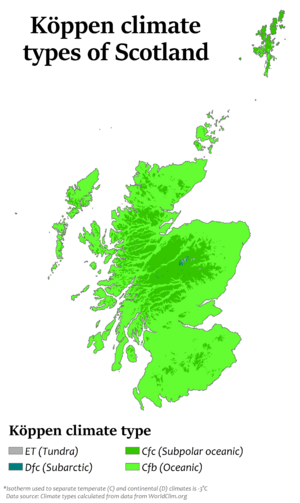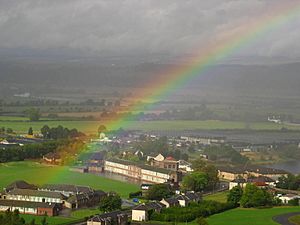Climate of Scotland facts for kids

The climate of Scotland is mostly mild and wet. It has an oceanic climate, which means it's often cloudy and rainy. The weather in Scotland can change very quickly, but it's rarely extremely hot or cold.
Scotland's climate is made warmer by the Gulf Stream. This is a warm ocean current from the Atlantic. Because of this, Scotland is much warmer than other places at the same northern latitude. For example, places like Kamchatka in Russia or Labrador in Canada are much colder. In Canada, the sea can freeze in winter, and temperatures of −35 °C (−31 °F) are common. Scots sometimes use the word dreich to describe gloomy or grey weather.
Contents
How Warm or Cold It Gets
Scotland is in the cooler northern part of Great Britain. This means temperatures are generally lower than in other parts of the British Isles. The coldest temperature ever recorded in the UK was −27.2 °C (−17.0 °F). This happened in Braemar in the Grampian Mountains in 1982. It was also recorded in Altnaharra, Highland, in 1995.
In winter, the average low temperature in Scotland is around 0 °C (32 °F). Summer high temperatures usually average between 15–17 °C (59–63 °F). Areas along the western coast are often warmer than the east. This is because of the warm Atlantic currents. The North Sea on the east coast tends to be colder. The highest official temperature ever recorded in Scotland was 34.8 °C (94.6 °F). This happened in Charterhall, Scottish Borders, on July 19, 2022.
Looking back 100 years, the coldest winter was in 1963. Its average temperature was 0.19 °C or 32.34 °F. The mildest winter was in 1989, with an average of 5.15 °C or 41.27 °F. The warmest summer was in 2003, averaging 14.07 °C or 57.33 °F. The coolest summer was in 1922, with an average of 10.64 °C or 51.15 °F.
How Much Rain Falls
The amount of rainfall in Scotland changes a lot from place to place. The western highlands of Scotland are very wet. They get up to 4,577 mm (180.2 in) of rain each year. This makes them one of the wettest places in Europe.
This heavy rain in the western Highlands is caused by mountains. When warm, wet air from the Atlantic hits the mountains, it has to rise. As it rises, it cools down and forms clouds. This process is called orographic precipitation.
In contrast, much of eastern Scotland gets less rain. It receives less than 870 mm (34.3 in) annually. This area is in a "rain shadow" because the western mountains block the rain. This effect is strongest along the coasts of Lothian, Fife, Angus, and eastern Aberdeenshire. It also affects the city of Inverness.
For example, Inchkeith in the Firth of Forth gets only 550 mm (21.7 in) of rain each year. This is similar to Rabat in Morocco. It's even less than what Barcelona receives each year. The north-western coast has about 265 rainy days a year. This number drops to about 170 days along the south-east coast.
Snowfall is not as common in the low-lying areas. However, it becomes more common as you go higher up. Parts of the Highlands can have between 36 and 105 days with snow each year. Some western coastal areas get snow for about 12 to 17 days a year.
How Much Sunshine Scotland Gets
The most sunshine recorded in one month was 329 hours. This happened in Tiree in May 1946 and again in May 1975. The least sunshine was only 36 minutes. This was recorded at Cape Wrath in the Highlands in January 1983.
Dundee and Aberdeen are the sunniest cities in Scotland. On the longest day of the year, the northern islands of Scotland never get completely dark. Lerwick, in the Shetland, has about four more hours of daylight in midsummer than London. However, this changes in midwinter, when London has more daylight.
The average yearly sunshine varies across Scotland. The highlands and north-west get about 711–1140 hours of sunshine. The extreme eastern and south-western coasts get more, about 1471–1540 hours. On average, Scotland gets about 1160 hours of sunshine per year. This means the sun shines just over 25% of the time.
How Windy It Is
Scotland is the windiest country in Europe. This is because of Atlantic storms that move eastward. These storms bring strong winds and clouds all year round. Like the rest of the United Kingdom, the wind usually blows from the south-west.
The windiest parts of Scotland are in the north and west. Areas like the Western Isles, Orkney, and Shetland have over 30 days with gale force winds each year. Strong Atlantic storms, also called European windstorms, are common in Scotland during autumn and winter.
The strongest wind gust officially recorded in Scotland was 278 km/h (173 mph). This happened in the Cairngorms on March 20, 1986. An unofficial wind speed of 312 km/h (194 mph) was recorded in the same place on December 19, 2008.
Climate change
See also
 In Spanish: Clima de Escocia para niños
In Spanish: Clima de Escocia para niños



